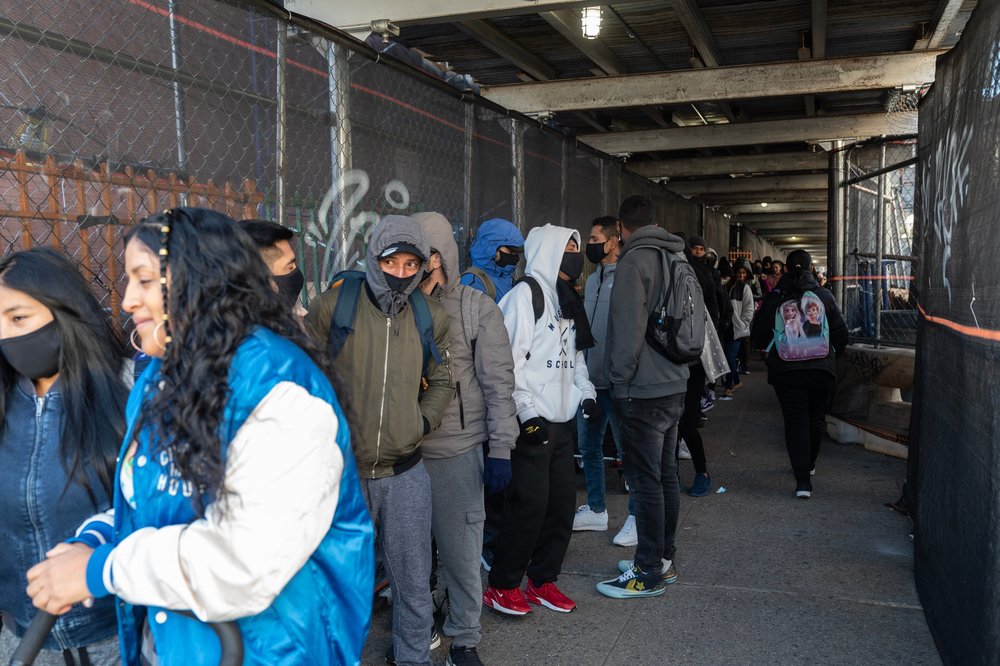How Mayor Adams was able to bypass NYC’s decades-old right-to-shelter rules
May 12, 2023, 8:30 a.m.
Th attorney who led the fight for the landmark right-to-shelter agreement said the legality of the mayor’s order hinges on one crucial concept.

The peeling back of New York City’s longstanding shelter laws happened with the stroke of a pen.
By signing an executive order on Wednesday, Mayor Eric Adams suspended portions of a landmark right-to-shelter law that has governed New York City’s unique approach to homelessness for more than three decades. At its core, the right to shelter requires the city to guarantee a bed to any person who requests one.
The order, which is in effect for five days but can be renewed, comes as Adams struggles to shelter the more than 37,500 asylum seekers that are straining the city’s shelter system.
It suspends three major shelter requirements: Ensuring that families who request a bed receive one within a certain time frame; that families be assigned private units with a bathroom, refrigerator and kitchen rather than in congregate settings; and that certain tenant protections exist for those staying at a dwelling unit for 30 or more days.
The mayor’s decision drew sharp criticism from many elected officials. Public Advocate Jumaane Williams called the right to shelter the city’s “legal and moral obligation.”
So how was the mayor able to so easily bypass the city’s right-to-shelter rules?
Legal Aid is among those currently evaluating the legal standing of executive order. In a joint statement with the Coalition for the Homeless, the advocacy group said Adams “is heading down a dangerous road.”
Asked about the threat of a legal challenge, Fabien Levy, the mayor’s press secretary said, “We are confident in our legal analysis.”
One principle is clear, according to Robert Hayes, the attorney who brought the original case — Callahan v. Carey — that led to the first court-ordered, right-to-shelter agreement.
“The executive order cannot violate the terms of a court order without the court’s expressed permission,” he said.
Hayes, who took the case pro bono while working at a Wall Street law firm, said any legal challenge of the mayor’s executive order would have to prove that the rules he is changing are tied to those court orders.
“Somebody has to figure out whether the four corners of the mayor’s modification violate the four corners of the court orders,” he said.
Despite being described as a single law, the right to shelter consists of a series of landmark rulings and statutes dating back to 1981, when the city entered into a consent decree ordered by a judge.
The first agreement, which applied to homeless single men, became known as the Callahan consent decree, named after one of the plaintiffs in the class action suit.
It was followed by other court orders — such as one that expanded the right to shelter for single women — and city and state legislation enshrining those rights as well as other practices.
But by referring to statutes that did not originate from court orders, the mayor may be within his powers to temporarily loosen certain rules, Hayes said.
For example, two separate court orders established the right for single men and women to receive a bed by a certain time frame. But the court did not extend the same protection for families. A city statute eventually established that families who arrive at an intake center by 10 p.m. must be given a bed that night.
We make this commitment even when there are horrible moments in our history.
Norman Siegel, the former head of the New York Civil Liberties Union
Last July, the city broke the rule by allowing families to sleep in chairs at an intake center in the Bronx.
The other two modifications Adams is seeking — exempting the city from having to provide homeless families with units that have kitchens, refrigerators and bathrooms and suspending tenant protections for those who stay at a dwelling for 30 or more days — also relate to local statutes rather than court orders.
On tenant protections, the executive order would allow the city to move individuals staying in hotels or other types of shelter after 30 days without having to go through eviction proceedings in housing court.
“It would be cruel, but it probably does not violate the Callahan consent decree,” Hayes said.
The mayor has said the decision to suspend portions of the city’s right-to-shelter law was “difficult,” but the right one.
“No one thought about a humanitarian crisis when they first took this court case of right-to-shelter,” Adams told reporters Thursday.
Friday marked the first day after the pandemic-era immigration policy known as Title 42, which enabled the quick expulsion of some immigrants, was lifted. City officials are bracing for a substantial uptick in new arrivals.
Unlike Hayes, Norman Siegel, the former head of the New York Civil Liberties Union, contended that the mayor could not change the city’s right-to-shelter rules without making a case for it in court.
While he said he understood the mayor’s argument that the city was facing an emergency situation, he pointed to a Depression-era article in the state constitution that states the ”aid, care and support of the needy are public concerns.”
“We make this commitment even when there are horrible moments in our history,” he said.
This story has been updated to correct where Robert Hayes was working when he brought the Callahan case.
Mayor Adams orders exceptions to decades-old right-to-shelter law as NYC preps for more migrants NYC Council blasts conditions at migrant shelters: ‘We’re just warehousing people.’